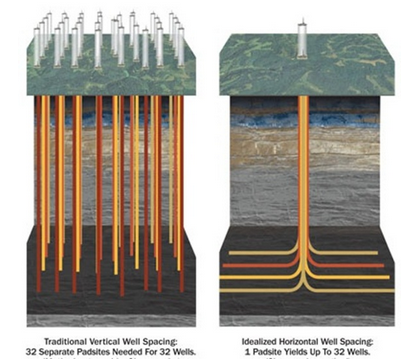Want to make a lot more money by doing a lot less work? If it were possible, I’m sure you would jump at the chance.
Of course you would. We all would. This is what many onshore oil and gas companies in the U.S. are doing. And it’s one of the big reasons that investors should make sure they have at least some equity exposure to the best in the group.
I’m sure you’ve read a lot about the U.S. energy boom in recent years. If you read beyond the headlines you’ll quickly see that there are some very real, exciting and profitable trends unfolding every day.
Possibly the biggest development in recent years is the ability of companies to tap into multiple oil formations from a single well pad. Many of these shale formations are layered, like a multi-flavored cake.
Each layer can be drilled independently. If you want chocolate you can tap into chocolate. If you want vanilla, you can get just that too. And if you want strawberry…well, you get the picture.
In many cases companies are learning to tap into multiple layers from a single drilling pad. And that’s yielding huge financial payoffs.
The image below shows the various layers of a typical Marcellus Shale (in Ohio) horizontal well versus vertical well. You can get a sense of exactly why horizontal drilling is such a breakthrough technique. By drilling down vertically, then turning and drilling sideways, exploration companies can access multiple layers from a single drill pad.

The vertical well on the left, with normal spacing, requires 32 padsites for 32 wells. In contrast the horizontal well on the right requires just 1 padsite to drill up to 32 wells.
Think about the efficiency gains of drilling this many more wells, and targeting multiple oil prone layers, all from one pad. That’s why companies are flocking to the Permian Basin, Marcellus and Eagle Ford. Operators claim this can save $600,000 to $700,000 per well, and bigger companies can average 10 wells per rig each month. That’s a lot more efficient than moving to a rig to a new pad to drill each new well.
That’s why liquids-rich plays like these generate such large returns for the explorers and producers. These tend to be between 40% – 55% according to Credit Suisse, when horizontal drilling is used. Less liquids-rich plays like the Barnett and Fayetteville shales tend to generate much lower returns, typically between 15% and 20%.
Horizontal wells have another benefit. They can go a mile or more into the reservoir rock formation, accessing far more oil and natural gas than a vertical well. Sure, they are a lot more expensive. Horizontal wells typically cost $7.5 to $8.5 million, versus $2.5 million for your typical vertical well.
But given the vast quantities of oil that horizontal wells produce over a much longer time horizon, horizontal wells can deliver returns double those delivered by vertical wells.
Of course, not all North American shale plays are created equal. And not all have the multiple liquid-rich layers that make horizontal drilling so profitable. While there are more than 40 shale plays in North America, there is a wide range of factors that make certain shale plays more attractive than others.
 Facebook
Facebook
 Twitter
Twitter